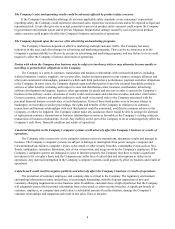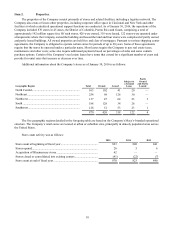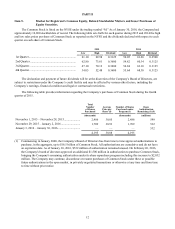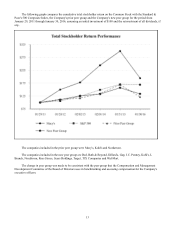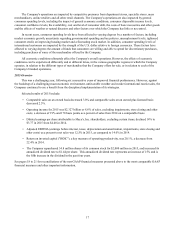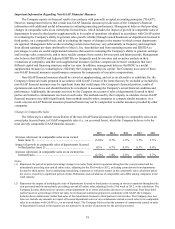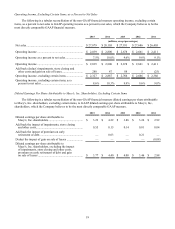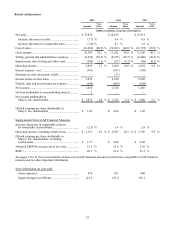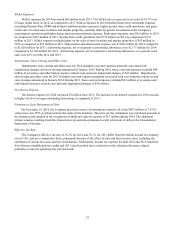Macy's 2015 Annual Report Download - page 23
Download and view the complete annual report
Please find page 23 of the 2015 Macy's annual report below. You can navigate through the pages in the report by either clicking on the pages listed below, or by using the keyword search tool below to find specific information within the annual report.
18
Important Information Regarding Non-GAAP Financial Measures
The Company reports its financial results in accordance with generally accepted accounting principles ("GAAP").
However, management believes that certain non-GAAP financial measures provide users of the Company's financial
information with additional useful information in evaluating operating performance. Management believes that providing
changes in comparable sales on an owned plus licensed basis, which includes the impact of growth in comparable sales of
departments licensed to third parties supplementally to its results of operations calculated in accordance with GAAP assists
in evaluating the Company's ability to generate sales growth, whether through owned businesses or departments licensed to
third parties, on a comparable basis, and in evaluating the impact of changes in the manner in which certain departments
are operated. Management believes that excluding certain items that may vary substantially in frequency and magnitude
from diluted earnings per share attributable to Macy's, Inc. shareholders and from operating income and EBITDA as
percentages to sales are useful supplemental measures that assist in evaluating the Company's ability to generate earnings
and leverage sales, respectively, and to more readily compare these metrics between past and future periods. Management
also believes that EBITDA and Adjusted EBITDA are frequently used by investors and securities analysts in their
evaluations of companies, and that such supplemental measures facilitate comparisons between companies that have
different capital and financing structures and/or tax rates. In addition, management believes that ROIC is a useful
supplemental measure in evaluating how efficiently the Company employs its capital. The Company uses some of these
non-GAAP financial measures as performance measures for components of executive compensation.
Non-GAAP financial measures should be viewed as supplementing, and not as an alternative or substitute for, the
Company's financial results prepared in accordance with GAAP. Certain of the items that may be excluded or included in
non-GAAP financial measures may be significant items that could impact the Company's financial position, results of
operations and cash flows and should therefore be considered in assessing the Company's actual financial condition and
performance. Additionally, the amounts received by the Company on account of sales of departments licensed to third
parties are limited to commissions received on such sales. The methods used by the Company to calculate its non-GAAP
financial measures may differ significantly from methods used by other companies to compute similar measures. As a
result, any non-GAAP financial measures presented herein may not be comparable to similar measures provided by other
companies.
Change in Comparable Sales
The following is a tabular reconciliation of the non-GAAP financial measure of changes in comparable sales on an
owned plus licensed basis, to GAAP comparable sales (i.e., on an owned basis), which the Company believes to be the
most directly comparable GAAP financial measure.
2015 2014 2013 2012 2011
Increase (decrease) in comparable sales on an owned
basis (note 1) ............................................................................ (3.0)% 0.7% 1.9% 3.7% 5.3%
Impact of growth in comparable sales of departments licensed
to third parties (note 2) ............................................................. 0.5% 0.7% 0.9% 0.3% 0.4%
Increase (decrease) in comparable sales on an owned plus
licensed basis............................................................................ (2.5)% 1.4% 2.8% 4.0% 5.7%
Notes:
(1) Represents the period-to-period percentage change in net sales from stores in operation throughout the year presented and the
immediately preceding year and all online sales, adjusting for the 53rd week in 2012, excluding commissions from departments
licensed to third parties. Stores undergoing remodeling, expansion or relocation remain in the comparable sales calculation unless
the store is closed for a significant period of time. Definitions and calculations of comparable sales differ among companies in the
retail industry.
(2) Represents the impact of including the sales of departments licensed to third parties occurring in stores in operation throughout the
year presented and the immediately preceding year and all online sales, adjusting for the 53rd week in 2012, in the calculation. The
Company licenses third parties to operate certain departments in its stores and online and receives commissions from these third
parties based on a percentage of their net sales. In its financial statements prepared in conformity with GAAP, the Company
includes these commissions (rather than sales of the departments licensed to third parties) in its net sales. The Company does not,
however, include any amounts in respect of licensed department sales (or any commissions earned on such sales) in its comparable
sales in accordance with GAAP (i.e., on an owned basis). The Company believes that the amounts of commissions earned on sales
of departments licensed to third parties are not material to its results of operations for the periods presented.


